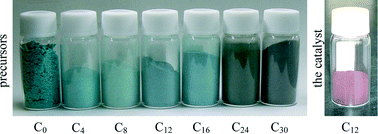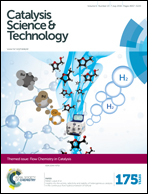Formic acid-assisted synthesis of highly efficient Cu/ZnO catalysts: effect of HCOOH/Cu molar ratios†
Abstract
A series of metallic Cu/ZnO catalysts were prepared by a novel formic acid-assisted solid-state combustion method with and without further reduction using metal nitrates and varied amounts of formic acid as raw materials. The states of the copper species of the as-burnt catalysts were mainly affected by two important catalyst preparation routes. One route was dissolution and reduction during the solid-state process; another was reduction during the calcination process. By gradually increasing the formic acid content, the copper species in the as-burnt catalysts changed from CuO to Cu2O, and from Cu2O to metallic Cu0. The X-ray diffraction (XRD), X-ray photoelectron spectroscopy (XPS), Energy Dispersive Spectroscopy (EDS), Temperature-Programmed Reduction (TPR), and High-Resolution Transmission Electron Microscopy (HRTEM) analysis revealed that the precursors with a HCOOH/Cu2+ ratio greater than 12/1, after being burnt in argon atmosphere and without further reduction, were absolutely converted into metallic Cu0 and ZnO species. With gradually increasing formic acid content, the catalysts exhibited a larger BET surface area, larger metallic Cu0 area, and smaller Cu crystallite size. The activity of the as-prepared catalysts was tested for low-temperature methanol synthesis. The total carbon conversion increased with increasing formic acid content. The variation trend was in accordance with that of the metallic Cu0 surface area. The methanol selectivity was closely related to metallic Cu0 crystallite size. The Cu crystallites with a smaller size exhibited higher hydrogenation capability to yield methanol.


 Please wait while we load your content...
Please wait while we load your content...